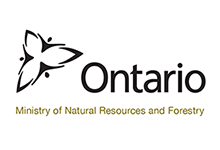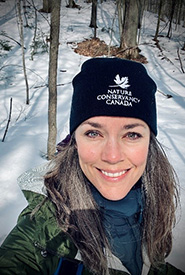Collaborating for conservation
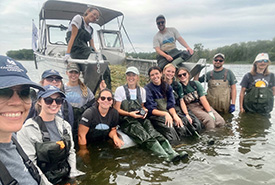
The cutting crew, comprised of staff from NCC, Georgian Bay Forever, Parks Canada, and the Severn Sound Environmental Association (Photo by Carolyn Davies/NCC Staff)
The natural world really is incredible. Spending time in it is a continual process of discovery, which is great for someone like me who is a life-long learner. For the past year and half at the Nature Conservancy of Canada (NCC), I’ve had the privilege of exploring new habitats as part of my job. I get to discover areas where species at risk are thriving, develop restoration plans and manage threats to biodiversity, such as invasive species. While I expected these to be the core activities of my role, I did not expect how wonderfully collaborative the conservation process would be!
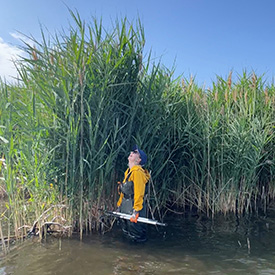
A patch of mature phragmites, with the lead technician for scale (Photo by Carolyn Davies/NCC Staff)
Everything in nature is interconnected in unique ways. My graduate research focused on native Ontario bumble bees and how each species interacts with the landscape differently. During field work, I witnessed habitat preferences: some species prefer closed forest habitat, while others prefer open grasslands. But in the spring, many species of bumble bees can be found in and around wetlands, collecting willow pollen to feed their establishing colonies.
These wetland habitats are threatened by invasive phragmites (also known as common reed), which crowd out native species and reduce biodiversity. Invasive phragmites disrupt native habitats and the species — such as bees and beyond — interacting with these habitats. At NCC, our goal is to protect and restore native habitats and biodiversity. This often requires controlling the spread of invasive species. NCC is leading some incredible landscape-scale control projects across Ontario, and in 2023 we expanded our efforts in southeastern Georgian Bay.
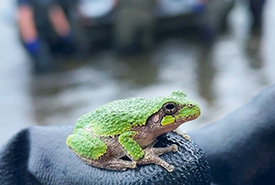
A grey tree frog, found among the phragmites and relocated (Photo by Carolyn Davies/NCC Staff)
With funding from Ganawenim Meshkiki’s Eastern Georgian Bay Initiative and the Green Shovels Invasive Phragmites Control Fund, we brought together six organizations to tackle invasive phragmites across southeastern Georgian Bay. At many sites, the invasive phragmites patches were dense and towered well above our heads. At other sites, the plants were widely dispersed across hectares of wetlands, which were difficult to access. By working as a collective, we were able to tackle invasive phragmites across eight hectares of wetlands and coastal areas in south Georgian Bay in just seven days! In the coming years, these wetlands and coastal areas will be annually monitored by our partner organizations, who will conduct follow-up control to ensure full eradication.
Together, we completed this work faster than had each of us done so separately, which is important for two reasons. Firstly, early detection and eradication is essential for controlling the spread of any invasive species. Secondly, water levels in Georgian Bay are declining as part of a natural fluctuation, exposing new areas for invasive phragmites to invade. This also makes it less effective to cut phragmites below the waterline to drown the plant, adding to the urgency.
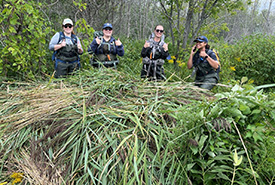
NCC technicians after a long day of cutting phragmites (Photo by Carolyn Davies/NCC Staff)
Our efforts this past summer were part of many across Ontario. Conservation organizations, government agencies, Indigenous communities and property owners are working together to manage invasive phragmites. This complex process includes planning, fundraising, monitoring, mapping, controlling and reporting on our collaborative efforts and the results. We have learned that, by working together, we support a healthier ecosystem that continues to provide the ecosystem services we all depend on, such as water filtration, oxygen production and plant pollination. And this benefits everyone — conservation of our planet is a truly collaborative activity and a shared responsibility.
NCC’s 2023 eastern Georgian Bay coast invasive phragmites control efforts would not be possible without the generous support of Moose Deer Point First Nation, Georgian Bay Forever, Georgian Bay Land Trust, Parks Canada - Georgian Bay Islands National Park and the Severn Sound Environmental Association.

